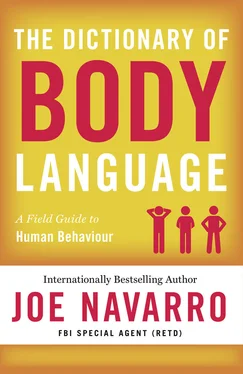Joe Navarro
The Dictionary of Body Language

While the manuscript for this book was reviewed by the Federal Bureau of Investigation (FBI) prior to publication, the opinions and thoughts expressed herein are those of the author exclusively.
Thorsons
An imprint of HarperCollins Publishers
1 London Bridge Street
London SE1 9GF
www.harpercollins.co.uk
First published in the US by HarperCollins Publishers 2018
This UK edition published by Thorsons 2018
FIRST EDITION
Text © Joe Navarro 2018
Cover layout design © HarperCollins Publishers Ltd 2018
Illustration credits: chapter head motifs the Head, the Eyes, the Mouth, the Chin, the Face, the Neck, the Shoulders, the Hands and Fingers, the Chest, Torso, and Belly, the Feet © Anna Rassadnikova/Shutterstock, Inc.; the Arms © freelanceartist/Shutterstock, Inc.; the Hips, Buttocks, and Genitals © Oksana Usenko/Shutterstock, Inc.; the Legs © makar/Shutterstock, Inc.
A catalogue record of this book is available from the British Library
Joe Navarro asserts the moral right to be identified as the author of this work
All rights reserved under International and Pan-American Copyright Conventions. By payment of the required fees, you have been granted the nonexclusive, non-transferable right to access and read the text of this e-book on screen. No part of this text may be reproduced, transmitted, downloaded, decompiled, reverse engineered, or stored in or introduced into any information storage retrieval system, in any form or by any means, whether electronic or mechanical, now known or hereinafter invented, without the express written permission of HarperCollins e-books.
Find out about HarperCollins and the environment at www.harpercollins.co.uk/green
Source ISBN: 9780008292607
Ebook Edition © August 2018 ISBN: 9780008292614
Version 2018-07-11
This book is dedicated to the love of my life, my best friend, and the first editor of everything I do—my wife, Thryth Hillary Navarro
If language was given to men to conceal their thoughts, then gesture’s purpose was to disclose them.
JOHN NAPIER
In 1971, at the age of seventeen, for reasons unknown to me then or now, I began to keep a journal on human behavior. I catalogued all sorts of “nonverbals”—what is more generally called body language. At first it was the quirky things people did: why did they roll their eyes when they were disbelieving or reach for their neck when they heard bad news? Later it became more nuanced: why did women play with their hair while on the phone or arch their eyebrows when they greeted one another? These were small actions, but they captured my curiosity. Why did humans do such things, in such variety? What was the purpose of these behaviors?
I admit it was an odd pursuit for a teenager. My friends told me as much; they were focused on trading baseball cards, knowing who had the best batting average or kicked the most extra points that season. I was far more interested in learning the intricacies of human behavior.
In the beginning I catalogued my observations on three-by-five-inch cards for my own benefit. At that time I was unfamiliar with the work of Charles Darwin, Bronisław Malinowski, Edward T. Hall, Desmond Morris, or my future friend Dr. David Givens—the giants in the field of human behavior. I was simply interested in how others acted, and why, and I wanted to preserve my observations. I never thought I would still be collecting them on index cards forty years later.
Over the years, I collected several thousand entries. Little did I know back then that I would later become an FBI Special Agent and would, for the next twenty-five years, use those observations as I pursued criminals, spies, and terrorists. But perhaps, given my interest in how and why people behave, that was the natural trajectory all along.
I CAME TO the United States as a refugee fleeing Communist-controlled Cuba. I was eight years old and didn’t speak English. I had to adjust quickly—in other words, I had to observe and decode my new surroundings. What native speakers took for granted, I could not. My new existence consisted of deciphering the only thing that made sense—body language. Through their countenance, their look, the softness in their eyes, or the tension in their face, I learned to interpret what others implied. I could figure out who liked me, who was indifferent toward my existence, whether someone was angry or upset with me. In a strange land, I survived by observing. There was no other way.
Of course, American body language was a little different from Cuban body language. People in America spoke with a different cadence and vibrancy. Cubans got close to one another when they spoke, and often touched. In America they stood farther apart, and social touching might receive an uncomfortable glance or worse.
My parents worked three jobs each, so they did not have the time to teach me these things–I had to learn them on my own. I was learning about culture and the influence it has on nonverbals, even if I couldn’t have put it in those words at the time. But I did know that some behaviors were different here, and I had to understand them. I developed my own form of scientific inquiry, observing dispassionately and validating everything I saw not once or twice but many times before it made its way onto an index card. As my cards grew in number, certain patterns in behavior began to stand out. For one, most behaviors could be broadly categorized as markers of either psychological comfort or discomfort; our bodies reveal very accurately, in real time, our state of unease.
I would later learn that many of these comfort markers or behaviors, to be more precise, originated in the mammalian or emotional areas of the brain—what is often referred to as the limbic system. This type of involuntary response squared with what I had seen in Cuba and was seeing now in America. At school or through the window at the corner store, people would flash their eyes with their eyebrows to greet those they truly liked. Such universal behaviors I grew to trust as authentic and reliable. What I did doubt was the spoken word. How often, after I had learned English, I heard people say they liked something when just an instant earlier I had seen their face reveal the complete opposite.
And so, too, I learned at an early age about deception. People often lie, but their nonverbals usually reveal how they actually feel. Children, of course, are terrible liars; they might nod to acknowledge they have done something bad even as they are verbally denying it. As we get older, we get better at lying, but a trained observer can still spot the signs that say something is wrong, there are issues here, a person does not appear to be completely forthcoming, or someone lacks confidence in what he is saying. Many of those signals or behaviors are collected here in this book.
As I grew older, I came to rely more and more on nonverbals. I relied on them at school, in sports, in everything I did—even playing with my friends. By the time I had graduated from Brigham Young University, I had collected more than a decade’s worth of observations. There, for the first time, I was living among many more cultures (east Europeans, Africans, Pacific Islanders, Native Americans, Chinese, Vietnamese, and Japanese, among others) than I had seen in Miami, and this allowed me to make further observations.
Читать дальше













